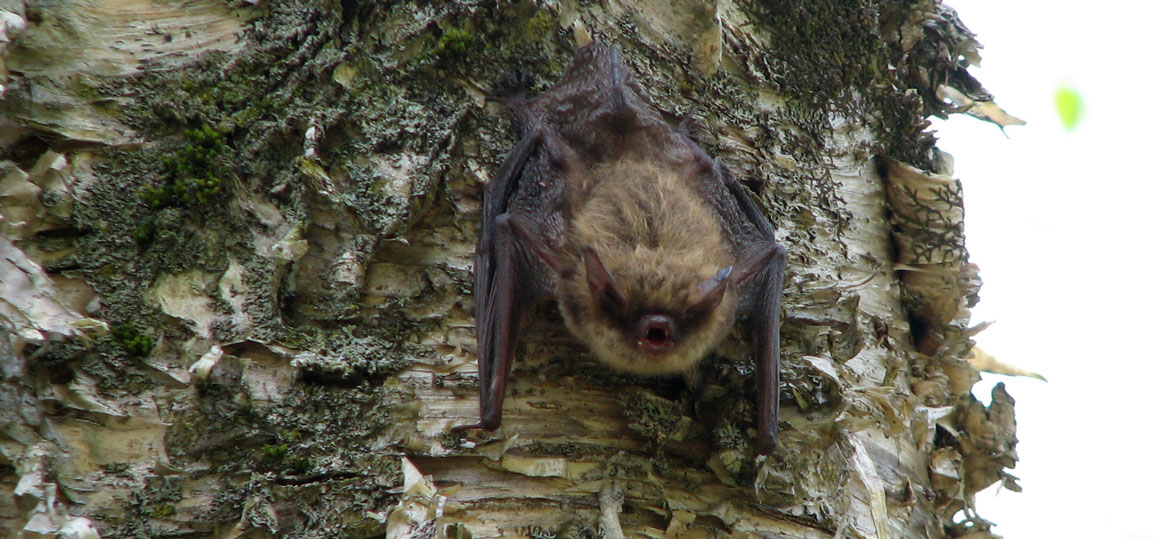
Little brown bats (Myotis lucifugus) are nocturnal, meaning that they are active at night. Bats are not blind, but they depend on their unique sonar system, called echolocation, to locate and catch prey during the hours of darkness. The bat sends out a steady signal of very short, high-pitched sounds that we can't hear. It scans the area, turning its head from side to side, sending out sound pulses through its mouth. The sounds bounce off objects and return to the bat as echoes. As the bat gets closer to an insect, it sends out more pulses of sound. These sounds continue to bounce back to the bat's large, sensitive ears until it can tell exactly where the insect is located. Once a bat has zeroed in on its prey, it may use its tail or wing membranes to scoop up the insect.
Little brown bats, and Vermont's eight other bat species, are critical components in a healthy ecosystem, foraging on insects that include both forest and agricultural pests. Their survival is essential for a sustainable natural environment.
Habitat
Little brown and big brown bats are frequently found in buildings, and sometimes in tree hollows or under peeling bark, and are often referred to as "house bats." These two species are common visitors to residences from mid-April to October, although the big brown bat may overwinter in attics. During the summer months, female little brown and big brown bats form colonies, sometimes in large numbers, in attics, barns, sheds or under shingles. This is where they give birth and raise their young. Males also frequent buildings, either alone or in small groups.
Reproduction
Mating occurs in mid- to late-autumn while swarming near the entrances of hibernation sites. Little brown bats have delayed fertilization, which means pregnancy begins in the spring as females leave hibernation to form nursery colonies. Females bear their single young in late June or July. At birth, each young weighs less than an ounce, its flesh colored skin covered with fine silky hair, the eyes opening within 24 hours.
Little brown bat pups, or young-of-the-year, huddle close together for warmth at the roost while their mothers go out to forage for insects. Bat pups are capable of flight at approximately 21 to 28 days. Pups must learn to forage for insects and become independent by late summer so they can put on enough fat to make it through their first winter. Yearling females may bear young, but males do not breed until the end of their second summer.
Diet
Bats can consume up to half their weight in insects each night during the summer. Little brown bats forage from dusk to dawn, taking small breaks to digest their enormous meal while hanging out at night roosts or returning to the colony to nurse young. Using echolocation, they capture insects with their teeth or tail membrane.
Management
Little brown bat management in Vermont is focused on studying the population in relation to White-nose Syndrome (WNS). WNS has caused unprecedented mortality of six species of cave bats, which are bats that hibernate in caves and mines in the winter months. The disease was first documented in New York State during the winter of 2006 and has spread to 25 states and five Canadian provinces.
Vermont Fish & Wildlife Department, US Fish and Wildlife Service, US Forest Service, and private organizations are working together to search for solutions to help our bat populations overcome WNS.
The public can also play a role in the future of bats by providing habitat (i.e., dead and dying trees, bat houses) and monitoring bat colonies that roost in buildings.
Status
State Endangered
Vermont is home to nine bat species. The Vermont Agency of Natural Resources listed the little brown, northern long-eared, and tricolored bats as endangered due to the high mortality caused by WNS. Current research indicates these three species' populations have been reduced by 90% or more due to WNS, and the northern long-eared bat has been proposed for federal endangered species protection.. Other bat species currently on the Vermont endangered species list include the state-threatened small-footed bat and the state and federally endangered Indiana bat.
